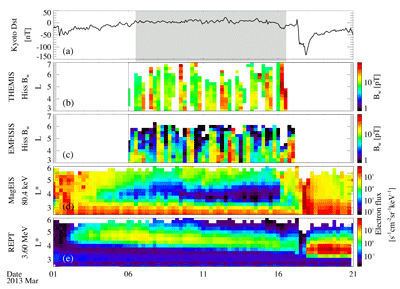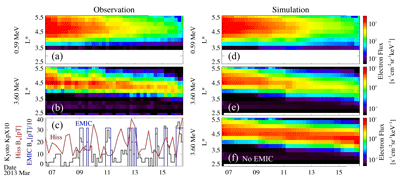
2015 THEMIS SCIENCE NUGGETS
Modeling inward diffusion and slow decay of energetic electrons in the Earth's outer radiation belt
by Qianli Ma
UCLA AOS
Introduction
During quiet geomagnetic periods, the evolution of the energetic electron population in the Earth's outer radiation belt is governed by the source caused by radial diffusion and the loss due to pitch angle scattering. Plasmaspheric hiss is a major candidate for the loss of energetic electrons at energies higher than tens of keV inside the plasmasphere, and electromagnetic ion cyclotron (EMIC) waves can cause efficient losses of highly relativistic (> MeV) electrons. During the 10-day period prior to the 17 March 2013 geomagnetic storm, the Van Allen Probes observed the gradual inward transport and weak loss of relativistic electron fluxes. Coupling of real-time radial diffusive transport and pitch angle scattering loss is required to explain the detailed electron flux evolution.
| Figure 1. Evolution of waves and electrons observed during 1–21 March 2013. (a) Dst index; (b) THEMIS observations of hiss magnetic wave amplitude (Bw); (c) Van Allen Probes observation of hiss Bw; electron differential flux for a pitch angle of ~90° and an energy of (d) ~80.4 keV and (e) ~3.60 MeV. The grey-shaded area indicates the simulation interval. |
Results
The Van Allen Probes and THEMIS spacecraft have provided excellent observations on the slow diffusion processes of energetic electrons and the associated plasma waves in March 2013. The Dst index (Figure 1a) remained higher than -30 nT during the 10-day quiet period from March 06 to March 16. Moderately strong plasmaspheric hiss which may cause the decay of energetic electrons was observed by THEMIS near noon (Figure 1b). The Van Allen Probes observed weaker plasmaspheric hiss waves on the nightside (Figure 1c). Strong injections of plasmasheet electrons (Figure 1d) were observed during the geomagnetic storms on 1 March and 17 March respectively. During the 10-day quiet period, only weak variations in the plasmasheet electron flux were observed near L* = 5.5. The highly relativistic electron flux (3.60 MeV) exhibited a clear tendency for gradual inward radial diffusion (Figure 1e). At 1200 UT on 6 March, the peak of the electron flux for an energy of 3.6 MeV was at around L* = 4.5. The peak of the electron flux gradually moved inward to L* = 4.0 and slowly decayed by approximately an order of magnitude over 10 days.
| Figure 2. The comparison between observation and simulation of equatorially mirroring electron fluxes. The Van Allen Probes observation of electron differential flux as a function of L* for an energy of (a) 0.59 MeV and (b) 3.6 MeV; (c) the Kyoto Kp index multiplied by 10 (black line), the hiss wave amplitude averaged over L = 4 to 5 (red line), and the EMIC wave amplitude with an intensity of Bw2 = 0.1 nT2 when Kp ≥ 2 (blue line); simulation results of electron differential flux as a function of L* for an energy of (d) 0.59 MeV and (e) 3.60 MeV; (f) simulation without EMIC wave scattering for an energy of 3.60 MeV. |
We have developed a 3D radiation belt model to simulate the energetic electron flux evolution between L = 2.5 and L = 5.5 during the 10-day quiet period. The electron phase space density (PSD) at higher L shell boundary and lower energy boundary are obtained from the Van Allen Probes measurements. The radial diffusion rate is calculated as the sum of electric and magnetic components. The hiss wave model is obtained from the real-time satellite observations, and the EMIC wave model is obtained from statistical surveys. The measurements by the MagEIS instrument (Figure 3a) and the REPT instrument (Figure 3b) clearly show the gradual inward diffusion and slow decay of electrons. The simulation of the same energy bands (Figure 3d,e) agrees fairly well with the Van Allen Probes observations. During the 10-day period, both the observation and simulation show that: 1) the peak location of relativistic electron fluxes gradually moved inward by ~0.5 RE; 2) the peak values of the electron fluxes gradually decreased by about an order of magnitude. In absence of EMIC wave scattering (Figure 3f), the 3.6 MeV electron flux increases in association with the inward radial transport. Our simulation shows that the intrusion of electrons is controlled by radial diffusion process, the decay at energies below 1 MeV is caused by hiss wave scattering, and the decay at energies higher than 1 MeV is caused by the combination of hiss and EMIC wave scattering.
Conclusion
We used a 3D radiation belt model to simulate the evolution of energetic electron fluxes during a 10-day period. The radial diffusion process in our simulation produces L-time profiles consistent with observations. Plasmaspheric hiss provides reasonable loss rates for the electrons below ~1 MeV, and weak EMIC wave causes the loss of the electrons above ~1 MeV. The coupled processes of radial diffusion and pitch angle scattering by hiss and EMIC waves successfully reproduced the essential features of quiet-time electron dynamics.
Reference
Ma, Q., W. Li, R. M. Thorne, B. Ni, C. A. Kletzing, W. S. Kurth, G. B. Hospodarsky, G. D. Reeves, M. G. Henderson, H. E. Spence, D. N. Baker, J. B. Blake, J. F. Fennell, S. G. Claudepierre, and V. Angelopoulos (2015), Modeling inward diffusion and slow decay of energetic electrons in the Earth's outer radiation belt, Geophys. Res. Lett., 42: 987–995, doi: 10.1002/2014GL062977.Biographical Note
Qianli Ma is a fifth year PhD student in space physics at University of California, Los Angeles. He is studying the global distribution, excitation, propagation, and potential effects in particle scattering of magnetosonic waves in the Earth’s inner magnetosphere..
 Please send comments/suggestions to
Emmanuel Masongsong / emasongsong @ igpp.ucla.edu
Please send comments/suggestions to
Emmanuel Masongsong / emasongsong @ igpp.ucla.edu


